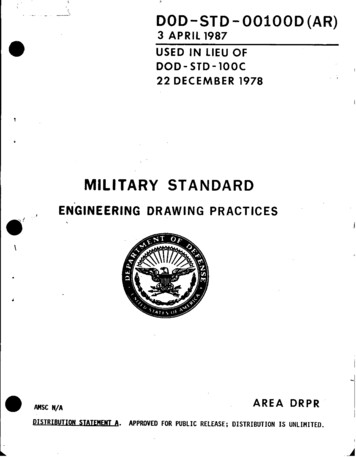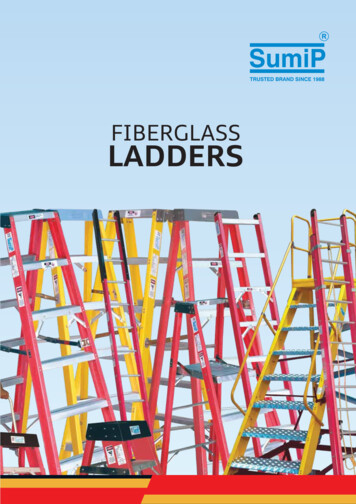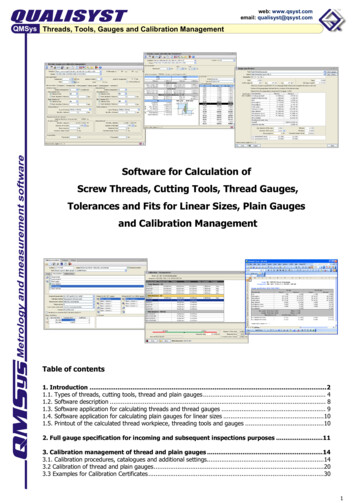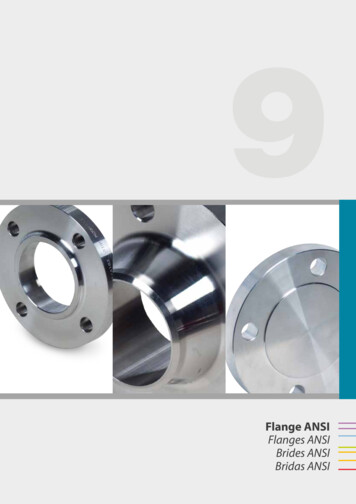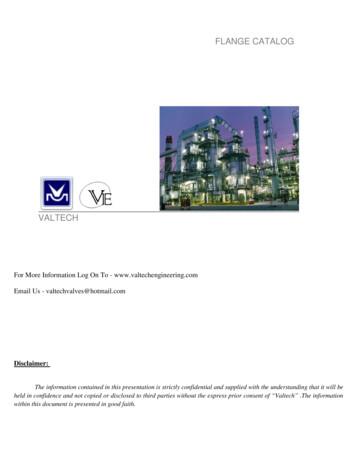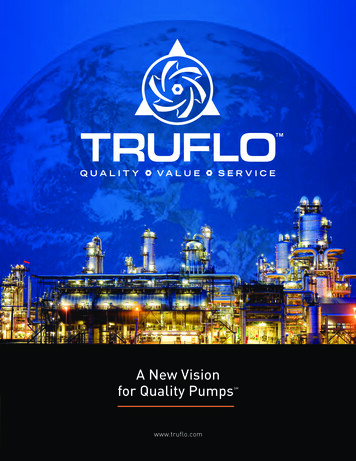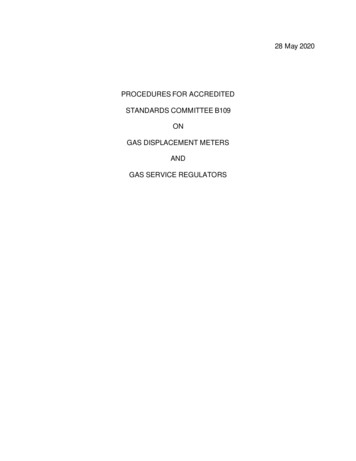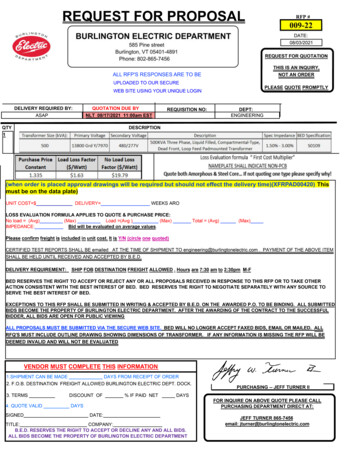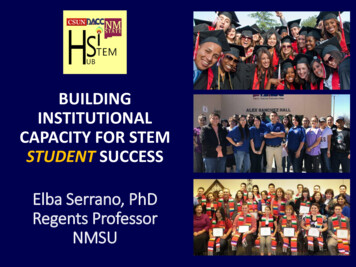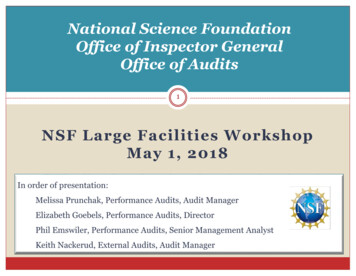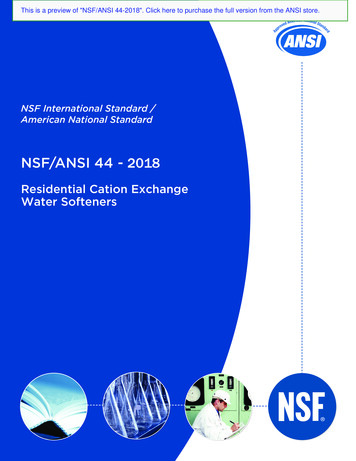
Transcription
This is a preview of "NSF/ANSI 44-2018". Click here to purchase the full version from the ANSI store.NSF International Standard /American National StandardNSF/ANSI 44 - 2018Residential Cation ExchangeWater Softeners
This is a preview of "NSF/ANSI 44-2018". Click here to purchase the full version from the ANSI store.NSF International, an independent, notfor-profit, nongovernmental organization,is dedicated to being the leading globalprovider of public health and safety-basedrisk management solutions while servingthe interests of all stakeholders.This Standard is subject to revision.Contact NSF to confirm this revision is current.Users of this Standard may request clarifications andinterpretations, or propose revisions by contacting:Chair, Joint Committee on Drinking Water Treatment Unitsc/o NSF International789 North Dixboro Road, PO Box 130140Ann Arbor, Michigan 48113-0140 USAPhone: (734) 769-8010 Telex: 753215 NSF INTLFax: (734) 769-0109E-mail: info@nsf.orgWeb: www.nsf.org
This is a preview of "NSF/ANSI 44-2018". Click here to purchase the full version from the ANSI store.NSF/ANSI 44 – 2018NSF International Standard /American National Standardfor Drinking Water Treatment Units –Residential Cation ExchangeWater SoftenersStandard DeveloperNSF InternationalDesignated as an ANSI StandardJuly 31, 2018American National Standards Institutei
This is a preview of "NSF/ANSI 44-2018". Click here to purchase the full version from the ANSI store.Prepared byThe NSF Joint Committee on Drinking Water Treatment UnitsRecommended for adoption byThe NSF Council of Public Health ConsultantsAdopted byNSF InternationalDecember 1987Revised November 1996Revised May 2000Revised February 2002Revised October 2007Revised December 2013Revised January 2017Revised November 1998Revised November 2000Editorial revision December 2003Revised August 2009Revised January 2015Revised November 2017Revised September 1999Revised January 2001Revised June 2004Revised February 2012Revised October 2015Revised December 2018Published byNSF InternationalPO Box 130140, Ann Arbor, Michigan 48113-0140, USAFor ordering copies or for making inquiries with regard to this Standard, please reference the designation“NSF/ANSI 44 –2018.”Copyright 2019 NSF InternationalPrevious editions 2017, 2016, 2015, 2013, 2012, 2009, 2007, 2004, 2002, 2001, 2000, 1999, 1998, 1996,1987Unless otherwise specified, no part of this publication may be reproduced or utilized in any form or by anymeans, electronic or mechanical, including photocopying and microfilm, without permission in writing fromNSF International.Printed in the United States of America.ii
This is a preview of "NSF/ANSI 44-2018". Click here to purchase the full version from the ANSI store.Disclaimers 1NSF International (NSF), in performing its functions in accordance with its objectives, does not assume orundertake to discharge any responsibility of the manufacturer or any other party. The opinions and findingsof NSF represent its professional judgment. NSF shall not be responsible to anyone for the use of or relianceupon this Standard by anyone. NSF shall not incur any obligation or liability for damages, includingconsequential damages, arising out of or in connection with the use, interpretation of, or reliance upon thisStandard.NSF Standards provide basic criteria to promote sanitation and protection of the public health. Provisionsfor mechanical and electrical safety have not been included in this Standard because governmentalagencies or other national standards-setting organizations provide safety requirements.Participation in NSF Standards development activities by regulatory agency representatives (federal, local,state) shall not constitute their agency's endorsement of NSF or any of its Standards.Preference is given to the use of performance criteria measurable by examination or testing inNSF Standards development when such performance criteria may reasonably be used in lieu of design,materials, or construction criteria.The illustrations, if provided, are intended to assist in understanding their adjacent standard requirements.However, the illustrations may not include all requirements for a specific product or unit, nor do they showthe only method of fabricating such arrangements. Such partial drawings shall not be used to justifyimproper or incomplete design and construction.Unless otherwise referenced, the Annexes are not considered an integral part of NSF Standards. TheAnnexes are provided as general guidelines to the manufacturer, regulatory agency, user, or certifyingorganization.1The information contained in this Disclaimer is not part of this American National Standard (ANS) and has not beenprocessed in accordance with ANSI’s requirements for an ANS. Therefore, this Disclaimer may contain material thathas not been subjected to public review or a consensus process. In addition, it does not contain requirements necessaryfor conformance to the Standard.iii
This is a preview of "NSF/ANSI 44-2018". Click here to purchase the full version from the ANSI store.This page is intentionally left blank.
This is a preview of "NSF/ANSI 44-2018". Click here to purchase the full version from the ANSI store.Contents1General . 11.11.21.31.4Purpose . 1Scope . 1Alternate materials, design, and construction . 1Treatment train. 12Normative references . 13Definitions . 24Materials . 24.14.24.35Structural performance . 115.16Hazards . 17Waste connections. 17Brine tank . 17Operation . 17Performance indication . 18Chemical and mechanical performance . 18Elective performance claims – Test methods . 317.17.27.38Structural integrity . 11Minimum performance requirements . 176.16.26.36.46.56.67Materials in contact with drinking water . 2Materials evaluation . 3Gas chromatography / mass spectroscopy (GC/MS) analysis . 5Scope . 31Barium and radium reduction . 34Conformance by calculation . 35Instruction and information . 388.18.28.3Installation, operation, and maintenance instructions. 38Data plate . 40Performance data sheet . 40Annex A Key elements of a certification program for drinking water treatment systems andcomponents . 43A.1A.2A.3A.4A.5A.6A.7A.8A.9Marking the product . 43Listing certified companies . 43Annual audits . 43Testing . 44Toxicological evaluation of materials formulations . 44Corrective action . 44Enforcement. 44Administrative review . 44Appeals . 44v
This is a preview of "NSF/ANSI 44-2018". Click here to purchase the full version from the ANSI store.A.10A.11A.12A.13A.14Complaints . 45Advertising . 45Records . 45Public notice. 45Confidentiality . 45Annex B . 47Annex C Evaluation methods for systems with multiple technologies – Treatment train . 49C.1 Requirements for the evaluation of a system containing multiple, sequential treatmenttechnologies . 49C.2 Example application of treatment train option B . 50C.3 Example application of treatment train option C . 51Interpretation Annex . 53vi
This is a preview of "NSF/ANSI 44-2018". Click here to purchase the full version from the ANSI store.Foreword 2The purpose of this Standard is to establish minimum requirements for materials, design, construction, andperformance of drinking water treatment units that are designed to reduce specific aesthetic-relatedcontaminants in public or private water supplies. This Standard specifies the minimum product literatureand labeling information that a manufacturer must supply to authorized representatives and system owners.Lastly, the Standard provides minimum service-related obligations that the manufacturer must extend tosystem owners.This edition of the Standard contains the following revisions:Issue 44The revision addresses inconsistent language across the scopes of the DWTU Standards and addsclarifying language on systems that include components or functions covered under other NSF Standards.This Standard was developed by the NSF Joint Committee on Drinking Water Treatment Units using theconsensus process described by the American National Standards Institute.Suggestions for improvement of this Standard are welcome. This Standard is maintained on a ContinuousMaintenance schedule and can be opened for comment at any time. Comments should be sent to Chair,Joint Committee on Drinking Water Treatment Units at standards@nsf.org, or c/o NSF International,Standards Department, PO Box 130140, Ann Arbor, Michigan 48113-0140, USA.2The information contained in this Foreword is not part of this American National Standard (ANS) and has not beenprocessed in accordance with ANSI’s requirements for an ANS. Therefore, this Foreword may contain material that hasnot been subjected to public review or a consensus process. In addition, it does not contain requirements necessaryfor conformance to the Standard.vii
This is a preview of "NSF/ANSI 44-2018". Click here to purchase the full version from the ANSI store.This page is intentionally left blank.
This is a preview of "NSF/ANSI 44-2018". Click here to purchase the full version from the ANSI store. 2018 NSFNSF/ANSI 44 – 2018NSF/ANSI Standardfor Drinking Water Treatment Units –Residential Cation Exchange Water Softeners1 General1.1PurposeThe purpose of this Standard is to establish minimum requirements for materials, design and construction,and performance of residential cation exchange water softeners. This Standard also specifies the minimumproduct literature that manufacturers shall supply to authorized representatives and owners, as well as theminimum service-related obligations that manufacturers shall extend to owners.1.2ScopeThe manual, auto-initiated, and demand-initiated regeneration (DIR) residential cation exchange watersofteners addressed by this Standard are designed for the reduction of specific substances that may bepresent in drinking water (public or private) considered to be microbiologically safe and of known quality.Systems covered under this standard are intended to reduce hardness affecting the aesthetic quality ofwater. The established health hazards, barium and radium, are optional performance claims addressed bythis Standard. Systems with manufacturer claims that include components or functions covered under otherNSF or NSF/ANSI Standards or Criteria shall conform to the applicable requirements therein. Systemscovered by this Standard are not intended to be used with drinking water that is microbiologically unsafe orof unknown quality without adequate disinfection before or after the system.NOTE — Systems that are compliant with NSF/ANSI 55 Class A or other standards that cover technologiesto treat microbiologically unsafe water (e.g., US EPA Guide Standard and Protocol for Testing MicrobiologicalWater Purifiers or NSF P231) are examples of demonstrating adequate disinfection before or after the system.1.3Alternate materials, design, and constructionWhile specific materials, design, and construction may be stipulated in this Standard, systems thatincorporate alternate materials, designs, and construction may be acceptable when it is verified that suchsystems meet the applicable requirements.1.4Treatment trainA system that contains multiple, sequential treatment technologies for a performance claim under thisStandard shall meet the applicable requirements as described in Annex C.2 Normative referencesThe following documents contain requirements that, by reference in this text, constitute requirements of thisStandard. At the time of publication, the indicated editions were valid. All of the documents are subject torevision and parties are encouraged to investigate the possibility of applying the recent editions of thedocuments indicated below. The most recent published edition of the document shall be used for undatedreferences.1
American National Standard . for Drinking Water Treatment Units - Residential Cation Exchange . Water Softeners. Standard Developer . NSF International . Designated as an ANSI Standard . July 31, 2018 . American National Standards Institute. This is a preview of "NSF/ANSI 44-2018". Click here to purchase the full version from the ANSI store.
